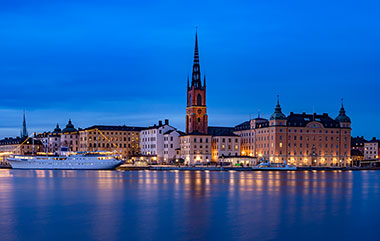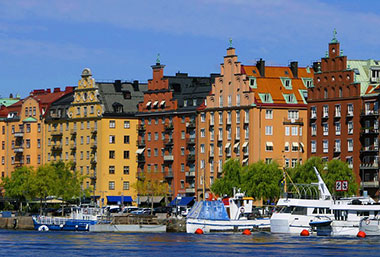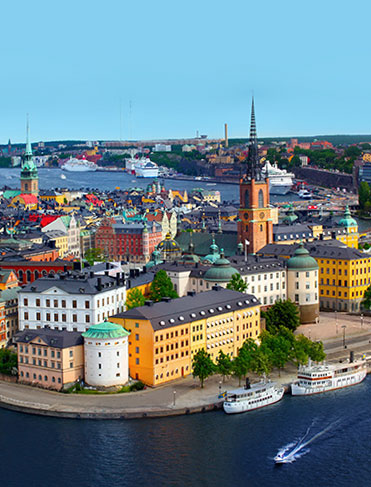Travel > Europe > Scandanavia > SwedenSwedenA Symphony of Scenery, Fjords, and Cultural CharmSweden, a land of enchanting contrasts, where timeless traditions harmoniously blend with cutting-edge innovation. Picture yourself wandering through ancient, storybook villages nestled beside tranquil lakes, under the mesmerizing glow of the Northern Lights in the Arctic Circle, or along the pristine coastlines of the Baltic Sea. Sweden is a captivating tapestry of lush forests, crystal-clear waters, and picturesque countryside, where you can savor the simplicity of life and the warmth of Swedish hospitality. Yet, it's also a realm of modern design, forward-thinking sustainability, and vibrant urban scenes, epitomized by the cosmopolitan charms of Stockholm and the tech-savvy hub of Gothenburg. Whether you seek the solace of nature or the buzz of a thriving metropolis, Sweden's allure is as diverse as it is irresistible, inviting you to experience a captivating Nordic adventure like no other." Stockholm:
Gothenburg (Göteborg):
Malmö
Visby:
Kiruna
Culinary Highlights:Sweden offers several traditional dishes that you can try to enhance your experience. Some of the most popular traditional dishes in Sweden include:(Köttbullar): Swedish meatballs are perhaps one of the most iconic Swedish dishes. These flavorful, small meatballs, usually made from a mixture of ground beef and pork, are served with lingonberry sauce, creamy mashed potatoes, and often accompanied by a rich brown gravy. Ärtsoppa: Ärtsoppa is a traditional Swedish pea soup, usually made with yellow split peas, pork, and sometimes a whole ham hock. It's often served with mustard and Swedish pancakes (punchrullar) as a classic Thursday dish. Gravlax: Gravlax is a classic Swedish dish made from thinly sliced salmon that has been cured with a mixture of salt, sugar, and dill. It's often served with a sweet mustard sauce, bread, or as an appetizer with potatoes. Herring: Herring is a staple in Swedish cuisine, and you'll find it prepared in various ways, such as pickled, fermented, or smoked. Pickled herring is often served with a variety of flavorful sauces, including mustard, onion, and dill. Husmanskost: Husmanskost refers to traditional Swedish home-cooked meals that vary by region. These dishes often feature hearty ingredients like cured ham, peas, and brown beans, typically served with lingonberry sauce and potatoes. Janssons Frestelse: This creamy potato and anchovy casserole is a comfort food favorite in Sweden. Sliced potatoes and onions are layered with anchovies, cream, and breadcrumbs, then baked to perfection. Kaldolmar: Kaldolmar are Swedish cabbage rolls filled with a mixture of ground beef and pork, rice, and spices. They are simmered in a flavorful broth and served with lingonberry sauce and potatoes. Lutfisk: Lutfisk is a unique Swedish dish made from dried whitefish (usually cod) that has been rehydrated with lye and then reconstituted by soaking it in water. It is often served with a white sauce, green peas, and potatoes. Palt: Palt is a traditional dish from northern Sweden, similar to dumplings or potato cakes. It's made from grated raw potatoes and barley or wheat flour, often filled with a mixture of pork and onions, and then boiled. Pyttipanna: Pyttipanna is a traditional Swedish hash made with diced leftover meat (usually beef or pork) and potatoes, often accompanied by onions. It's commonly served with a fried egg and pickled beets. Raggmunk: Raggmunk is a Swedish potato pancake that's crispy on the outside and tender on the inside. It's typically served with lingonberry jam and bacon, creating a sweet and savory combination. Renskav: In northern Sweden, sautéed reindeer is a delicacy. The meat is typically thinly sliced and cooked with butter, often served with lingonberry sauce and potatoes or mashed root vegetables. Smörgåstårta: Smörgåstårta is a unique Swedish dish that resembles a savory sandwich cake. It consists of layers of bread, fillings like egg salad, ham, cheese, and various toppings. It's a popular choice for special occasions and celebrations. Strömming: Strömming, or fried herring, is a popular street food in Sweden. It's typically served in a soft bread roll and topped with various condiments like mustard, onions, and pickles. Smörgåsbord: A traditional Swedish buffet, the smörgåsbord typically features an assortment of herring dishes, gravlax, smoked salmon, and other fish preparations. It's a great way to sample a variety of fish delicacies in one sitting. Best Time to Visit:The best time to visit Sweden depends on your interests and the experiences you're seeking. Sweden experiences distinct seasons, each with its own unique charm and activities. Be aware that Sweden's climate can vary significantly across the country, so your choice of when to visit may also depend on the specific region you plan to explore. Spring (March to May): Spring in Sweden marks the end of the long, dark winter and the beginning of brighter days. As the snow melts, the landscape awakens with blossoming flowers and greenery. It's an excellent time for outdoor activities such as hiking and cycling, particularly in the southern parts of Sweden. Stockholm and other cities come to life with outdoor events and cultural festivals. Don't forget to experience the Valborgsmässoafton, the traditional Walpurgis Night celebration on April 30th, with bonfires and singing. Summer (June to August): Summer is the warmest and most popular season in Sweden. The weather is typically at its best, making it ideal for exploring the Swedish archipelagos, swimming in crystal-clear lakes, and enjoying outdoor activities like hiking, kayaking, and camping. The entire country is vibrant with festivals, including Midsummer (Midsommar) celebrations in late June, which offer a unique cultural experience with traditional dances, flower crowns, and feasting. Autumn (September to November): Autumn in Sweden is a season of stunning natural beauty as the leaves change to vibrant shades of red, orange, and gold. It's an excellent time for hiking in the forests, visiting national parks, and experiencing the tranquility of the Swedish countryside. The northern regions, such as Lapland, are particularly attractive during this season, offering a chance to witness the Northern Lights. Food enthusiasts can indulge in seasonal Swedish dishes and participate in local food festivals like the crayfish parties. Winter (December to February): Swedish winters can be cold, but they are also enchanting, especially if you're a fan of winter sports and festivities. Popular winter activities include skiing, ice skating, and dog sledding. Swedish Lapland is a prime location to witness the magical Northern Lights during the extended nights. The Christmas season is a special time to visit cities like Stockholm, Gothenburg, and Malmö, as they are adorned with holiday decorations and festive markets. Warm up in cozy cafés or saunas, and don't forget to try traditional Swedish holiday dishes like meatballs and ginger snaps. Travel Planning Tips:Plan Ahead: Before embarking on your Swedish adventure, take the time to research the cities, regions, and attractions that interest you. Create a list of must-see places and plan your itinerary accordingly. Sweden offers a diverse range of experiences, from historic cities to pristine natural landscapes, so tailor your trip to your preferences. Cash and Currency: Sweden uses the Swedish Krona (SEK) as its currency. Inform your bank about your travel plans to prevent any issues with your credit or debit cards. While cards are widely accepted, it's a good idea to carry some cash, especially for small purchases and in rural areas where card acceptance may be limited. Sweden has a cashless culture, so having a credit or debit card is essential. Tipping in Sweden is generally not as common as in some other countries, but it's appreciated for exceptional service, usually rounding up the bill or leaving a small tip. Travel Insurance: Ensure that you have comprehensive travel insurance that covers medical expenses, trip cancellation, and emergencies. Familiarize yourself with the policy details and know how to access medical assistance if needed. Check Visa Requirements: Depending on your nationality, you may need a visa to enter Sweden. Check visa requirements well in advance and apply if necessary. Ensure that your passport remains valid for at least six months beyond your planned departure date. Pack Accordingly: Sweden experiences a wide range of temperatures throughout the year. Pack clothing suitable for the season of your visit. Layers are useful for adapting to changing weather. Comfortable walking shoes are essential for exploring cities and attractions. Also, bring a universal power adapter for charging your electronic devices, as Sweden uses Type C and Type F electrical outlets. Local Etiquette: When in Sweden, respect local customs and etiquette. Swedes are known for their politeness and punctuality. Be sure to queue in an orderly fashion, and always say "please" (snälla) and "thank you" (tack) in your interactions with locals. Tipping is not as common as in some other countries, but it's appreciated for good service, usually rounding up the bill. Drinking tap water is safe and environmentally friendly, so bring a reusable water bottle to stay hydrated. Accommodations:Hotels: Sweden offers a wide range of hotels, from luxury to budget-friendly options. Many hotels are equipped with amenities for all types of travelers. You can inquire about any senior discounts or special rates when booking your stay. Guesthouses and Bed & Breakfasts: Guesthouses and B&Bs in Sweden provide a cozy and personalized experience. These accommodations are often run by local hosts who offer warm hospitality. Staying in a guesthouse or B&B allows retirees to interact with locals and immerse themselves in authentic Swedish culture. Spa and Wellness Resorts: For those seeking relaxation and wellness, Sweden has numerous spa and wellness resorts. These establishments offer rejuvenating treatments, saunas, and relaxation facilities. Consider staying at one of these retreats in picturesque areas like the Swedish Archipelago, Dalarna, or the Swedish Lapland, where you can unwind in natural beauty. Transportation:Sweden offers a diverse range of transportation options to cater to different travel preferences and needs, whether you prefer the convenience of public transportation, the flexibility of driving, or a mix of both to explore this beautiful country. Here's some helpful information for getting around in Sweden:SL Access Card: Stockholm, the capital of Sweden, has its own contactless smart card for public transport known as the "SL Access Card." This card can be used on buses, trams, the metro, commuter trains, and some ferries within the Stockholm County. The SL Access Card offers a convenient way to travel and can be preloaded with credit or various travel passes. You can obtain an SL Access Card at public transportation hubs, including Stockholm Arlanda Airport, train stations, and authorized retailers. Domestic Flights: While Sweden is relatively compact, domestic flights are available for longer journeys or travel to remote regions like the Swedish Lapland or Gotland. Airlines like Scandinavian Airlines (SAS) and regional carriers operate these routes. Flying can save time for more distant destinations, but it may not always be the most budget-friendly option for shorter trips. Trains: Sweden boasts a well-developed and efficient train network, operated by Swedish Railways (SJ). Trains connect major cities and regions, providing a convenient and scenic way to explore the country. Consider purchasing rail passes for extended travel, and booking tickets in advance is advisable, especially for peak times and long-distance routes. Buses: Buses are a popular mode of transportation for regional and local travel in Sweden. Companies like Flexibus (which also operates in the U.S.) and SJ Buss operate bus services that connect cities and rural areas. Similar to trains, booking tickets in advance is recommended, and bus services are cost-effective for reaching areas that may not have direct train connections. Rental Cars: Various international and local car rental companies operate in Sweden, including well-known brands like Hertz, Avis, Europcar, Enterprise, and Budget. You can find rental offices at major airports, cities, and popular tourist destinations. In Sweden, driving is on the right side of the road, and cars have the steering wheel on the left side. The road network is well-maintained, including highways (E-roads) and national routes (R-roads). Be prepared for varying road conditions, including narrow and winding roads, especially in rural areas. Be aware of wildlife on the road, especially moose and deer. Roundabouts are common traffic features, so familiarize yourself with roundabout rules and understand the proper lanes to use when approaching and exiting them. Taxis: Taxis in Sweden are generally safe and reliable. Look for licensed taxis with a taxi sign on the roof and a taxi meter inside. Fares are typically based on distance traveled, with additional charges for luggage or late-night rides. Taxis in Sweden typically accept both cash and credit cards. Tipping is customary and often involves rounding up the fare or offering a small additional amount. Public Transportation: Swedish cities have efficient public transportation systems, including buses, trams, and metros. Stockholm, for instance, has the SL Access Card, while other cities have their own networks. Tickets can usually be purchased from ticket machines or via mobile apps. Consider day passes or multi-day passes for unlimited travel within specific cities or regions. Safety Tips:
|
 Stockholm Skyline Stockholm SkylinePhoto by Mikael Damkier / Adobe Stock  Stortorget place in Gamla stan, Stockholm Stortorget place in Gamla stan, StockholmPhoto by Yves / Pixabay  Stockholm StockholmPhoto by Mikael Damkier / Adobe Stock | |||||||||||||||||||||